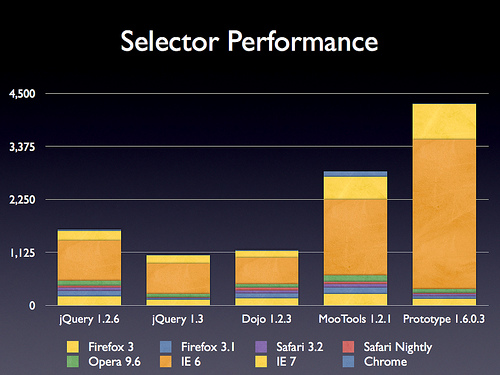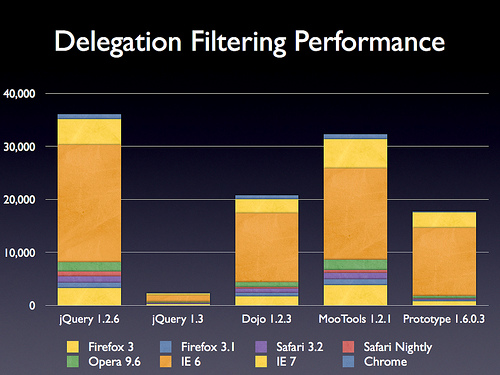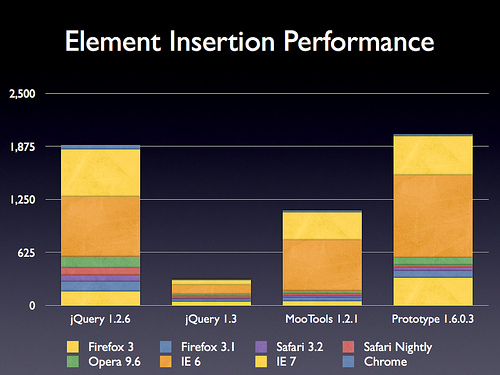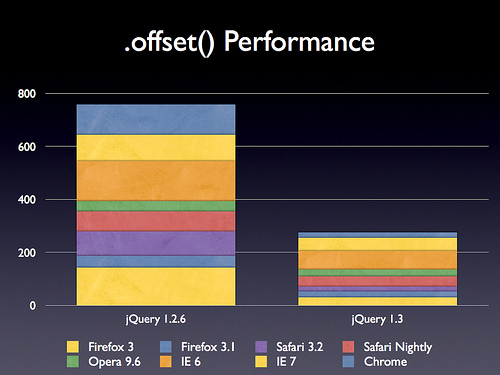Submitted by gouki on 2009, January 15, 4:13 PM
Something from jQuery's Blog :
Happy Birthday to jQuery! jQuery is three years old today, after being released way back on January 14th, 2006 at the first BarCampNYC by John Resig.
We have four announcements for you today, we hope you’ll enjoy them!
Url:http://blog.jquery.com/2009/01/14/jquery-13-and-the-jquery-foundation/
中文翻译:http://shawphy.com/2009/01/release-jquery-1-3.html
jQuery 1.3终于发布了。
min版(gzip后18kb)
源码(114kb)
另外可以用google的代码托管:
http://ajax.googleapis.com/ajax/libs/jquery/1.3/jquery.min.js
下面这个是我自己用Packer压缩的pack版
http://shawphy.com/down/jquery-1.3.pack.js(37kb)
简要来说:
更新了Sizzle选择器引擎,这个之前也提到过。可以查看他的性能:

此外据声称,把代码给了dojo基金会。这回Sizzle的野心在于能够让其他各种JS库都能用,包括Prototype, Dojo, Yahoo UI, MochiKit, 和 TinyMCE等等其他库。
live 事件
这也是jQuery 1.3这次更新的第二个重大更新。(注:这里有一个iframe,我没有复制过来,请到原站观赏和测试)
性能比较:

这样,我以前写的关于重复绑定的文章就差不多可以抛弃了
Event 对象
新增了一个jQuery.Event对象,他根据w3c文档,做了一个完整的,兼容所有浏览器的一个对象。具体还得看文档。
append, prepend, before, 和 after 方法重写
据声称,这些方法的效率提升了6倍

重写了offset方法
这回更快了

取消了浏览器侦测,全面改用jQuery.support
具体还得看文档了。
变化:
其中与开发者比较密切的是
[@attr] 中的@在1.3里不能用了
用trigger触发的事件现在能冒泡了
ready方法中,再也不等css加载完了再执行其中代码了。直接要求把css放在脚本之前就行
简化了.isFunction方法,那些偏门的就被无视了
用选择器a, b, c选择东西,在支持querySelectorAll (Safari, Firefox 3.1+, Opera 10+, IE 8+)中会按照这些元素在文档中顺序来确定这些数组在获得的对象列表中的位置。而不支持这个方法的浏览器则按照选择器顺序排好
新增了jQuery.Event
要求网页都在标准模式下,不要在怪异模式下使用,否则会报错。
以下3个方法属性已被不推荐使用。
* jQuery.browser
* jQuery.browser.version
* jQuery.boxModel
具体内容:
内核部分:
更好的queue, dequeue
新增selector, context这两个属性,分别指向获取这个元素的原始选择器和被查找的内容(可选)
选择器部分:
Sizzle的使用
复杂的css例如not(a, b)
属性部分:
toggleClass( “className”, state ) - 增加了一个布朗值的参数。
筛选文档:
.closest( selector ) - 找到离这个元素最近的一个父元素。这跟parents不一样。
is() 也支持更复杂的选择器了。
操作文档:
HTML Injection重写了
$(”<script/>”) 就自动转化为 $(document.createElement(”script”))
css:
offset()重写了
事件:
Live 事件
jQuery.Event
trigger()会冒泡了
效果:
hide() .show()之类的加快速度
内置动画效果考虑到了margin和 padding
.toggle( boolean ) 多提供了一个参数
jQuery.fx.off 关闭所有动画
AJAX:
.load()支持了文本格式的数据
工具:
新增jQuery.isArray
内部:
jQuery.support
另外这回改用YUI的工具压脚本了
========================================
最后预告一下,jQuery文档官网已经针对1.3版做了修改,中文文档也在紧张制作中。
Tags: jquery, 1.3, 三周年
Javascript | 评论:0
| 阅读:22976
Submitted by gouki on 2009, January 15, 11:42 AM
不知道你的函数在哪里被调用了?没关系。。
不知道你的函数在哪行?哪个方法?哪个参数里被触发?没关系。
请使用 debug_backtrace函数吧。
呵呵,好象广告一样。
看到这个函数,其实是有点意外的,本来是想好好的做一个LOG,然后想用个观察者模式,最初的发现是,如果我不主动将行数、函数名放进参数里,那就很难在处理的时候,得到这些信息,可以让我快带定位。
结果就看到了这个函数:debug_backtrace();
Table 1. Possible returned elements from debug_backtrace()
| Name |
Type |
Description |
| function |
string |
The current function name. See also __FUNCTION__. |
| line |
integer |
The current line number. See also __LINE__. |
| file |
string |
The current file name. See also __FILE__. |
| class |
string |
The current class name. See also __CLASS__ |
| object |
object |
The current object. |
| type |
string |
The current call type. If a method call, "->" is returned. If a static method call, "::" is returned. If a function call, nothing is returned. |
| args |
array |
If inside a function, this lists the functions arguments. If inside an included file, this lists the included file name(s). |
Tags: php, debug, trace
PHP | 评论:1
| 阅读:26323
Submitted by gouki on 2009, January 14, 10:32 PM
看起来很美的一个东西,生成sitemap的XML文件,这是CB上的某人投稿,第一遍我没看懂它的作用,再看还是没看懂,再看一遍发现有点懂了。但是我没有发现他究竟有什么好处,唯一让我感到的就是它应该会有点耗CPU吧?即使它是一个插件。。。
原文地址:http://www.cnbeta.com/articles/74798.htm
原文内容:新闻来源:http://www.sanliangfan.com/archives/974.html
网站地图对于搜索引擎索引网站是很 有帮助的,网上也有很多这样的软件、工具。比如 WordPress 平台的 Google XML Sitemaps 插件就是这方面的佼佼者,不过今天 Google 发布了他们自己制作的 Google Sitemap Generator (谷歌网站地图制作工具),帮助站长制作更好的网站地图文件。
关于 Google Sitemap Generator
Google Sitemap Generator 基于开源软件精神制作,完全免费。它能够通过分析网站流量、服务器文件和网站日志发现新的和修改过的网址。
通 过这些方法 Google Sitemap Generator 能够快速地找到这些网址并计算有关数据,从而使您的 Sitemaps 文件尽可能有效。一旦 Google Sitemap Generator 生成器完成网站网址收集任务,就可以为你的网站创建以下的网站地图文件:
1、XML Sitemaps :基于 sitemaps.org 标准的搜索引擎索引文件
2、Mobile Sitemaps :优化后的网站对于手机用户更加友好
3、Code Search Sitemaps :让你网站上的开源代码能够被使用者搜索到
此外 Google Sitemap Generator 还可以发送 Ping 到谷歌博客搜索,恩,这个功能我很是欣赏。虽然 WordPress 后台加一条 Ping 地址也能够完成同样的任务,但是对于其它类型的网站就会增加上谷歌博客搜索的机会。
当然还不止这些,有时候你更改了以前博客文章的链接, Google Sitemap Generator 会帮助你通知谷歌博客搜索修正数据库里的链接,这样就可以减少很多404错误的出现了。
Google Sitemap Generator 的博客 Ping 服务不仅仅只支持自家的博客搜索,同样也支持所有符合标准的其它博客搜索引擎。
使用 Google Sitemap Generator
Google Sitemap Generator 是一个服务器插件,可以同时安装在 Linux 的 Apache 和微软 IIS 服务器。与其他服务器端插件一样,安装的时候需要你拥有管理权限。更多的安装细节可以看这里 Google Sitemap Generator documentation 。
Tags: google, sitemap, generator, sprider
Software | 评论:0
| 阅读:20967
Submitted by gouki on 2009, January 14, 10:22 PM
IIS团队刚刚发表了IIS7在Window Server 2008 R2 beta中的新改进.Windows Server 2008 R2包括对IIS7 Web服务器的增补,对已经是史上最好的IIS平台进行修正、完善、添加。 今天在Windows Server 2008 R2 Beta中IIS7改进的主要亮点:
内容发布扩展(FTP, WebDav)集成进Web服务器OS/集成Administration Pack扩展到Windows Server OS
新的IIS7 PowerShell Provider和Commandlet支持/丰富的Server Core应用程序托管
改进的FastCGI支持/IIS核心更改/IIS Best Practice Analyzer
过去的一年半中,IIS产品团队在IIS7平台上辛勤编写扩展,发布了beta、TC和RTW们来新增对优化媒体托管、Web内容发布、站点和服务器管理、部署和迁移、请求处理的支持。 没有我们在Windows Server 2008上IIS7中引入的架构变更,我们根本无法在12~18个月中进行创新,并构建面向生产环境、完全受支持的微软软件。现在在Windows Server 2008 R2, 我们对这个IIS7平台再做了一些改进、修正和完善。
今天在Windows Server 2008 R2 Beta中IIS7改进的主要亮点:
内容发布扩展(FTP, WebDav)集成进Web服务器OS
继承内容发布扩展 (FTP, WebDav)进Windows Server OS
在Windows Server 2008发布前很久,我们就开始研发完全重写的FTP服务器和我们的WebDav实现。08年早些时候,我们发布了Windows Server 2008 FTP发布服务下载,具有FTPS安全内容发布、IPv6支持、IIS管理器集成管理FTP/HTTP站点、更强大的日志和认证支持的特性。跟我们所有的扩展一样,Windows Server 2008 FTP发布服务受到微软产品支持的完全支持及由专家用户和产品团队提供的论坛支持。我们在Windows Server 2008 R2中已经做到的是将FTP发布服务集成到服务器操作系统。
从客户角度,这意味着:
当Windows Server 2008上已经安装了FTP发布服务,你必须在安装新FTP服务前移除旧版。在R2中,你可以作为IIS组件的一部分来安装新的FTP服务器,IIS setup会替换升级旧的FTP服务。
你可以得到FTP发布服务自2008年2月发布后的bug修复。
你可以使用新增的认证、日志、授权和home目录扩展性,这些在MSDN上会有文档。
我们也会在2009年5月发布一个更新过的Windows Server 2008 FTP发布服务下载,所以这部分客户也能利用这些bug修复和扩展性。或者说:
(2009年5月版FTP下载 + Windows Server 2008) == (Windows Server 2008 R2中的FTP特性)
但有如下例外:
Windows Server 2008 FTP发布服务始终是一个下载安装,而Windows Server 20008 R2和以后会集成FTP。
2008年7月发布的WebDav也是一样。WebDav for Windows Server 2008提 供了HTTP协议WebDAV扩展的全新实现(直至spec)。我们在Windows Server 2008 R2安装中包含了WebDav。WebDav大的新特性是支持locks。我们也会为Windows Server 2008发布一个支持lock的WebDav,同样是2009年5月。同样地:
(2009年5月版WebDav下载 + Windows Server 2008) == (Windows Server 2008 R2中的WebDav特性)
如下例外:
WebDav for Windows Server 2008 始终是一个下载安装,而Windows Server 20008 R2和以后会集成WebDav。
集成Administration Pack扩展到Windows Server OS
我们把IIS7 Administration Pack集成到Windows Server 2008 R2,为客户提供:
在IIS Manager中集成管理ASP.NET authorization,自定义错误,FastCGI,和and Request Filtering。
配置管理器,提供管理IIS7配置系统的可视化编辑器。如果你想试用一下,我们的IIS开发经理Carlos Aguilar Mares撰写了comprehensive blog on the Config Editor's capabilities一文。我最爱的配置管理器部分是脚本生成功能——对做演示非常管用:)
我们并未将IIS Reports特性集成进Windows Server OS,如果你需要这个功能,你可以在IIS Administration Pack下载中得到。同样的,我们也会为Windows Server 2008用户提供更新的IIS Administration Pack,包括Windows Server 2008 R2种所有的修复和变更(除了集成安装)。
Windows Server 2008版的Administration Pack会和Windows Server 2008 R2一起发布,以确保功能和Windows Server 2008 R2一致。
新的IIS7 PowerShell Provider和Commandlet支持
IIS PowerShell provider,同样有Windows Server 2008版下载,允许用户使用PowerShell编程环境管理IIS,ASP.NET和自定义错误配置。是的,传说是真的——我们有为PowerShell用户们提供IIS:/>。我们的PowerShell支持提供了3个等级的支持:
PowerShell provider: 如果你熟悉IIS配置系统,想直接用PS编程环境来管理配置。
Low-level commandlets: 用我们的low-level commandlets集合来管理每个IIS设置,如果你需要这个程度的细粒度控制。
Task-oriented commandlets: 用我们的面向任务commandlets来管理网站(例如:New-WebSite创建一个站点),备份和恢复web服务器配置及其他常见任务。
集成到Windows Server 2008 R2中,你可以使用Windows Server setup来安装PowerShell provider和60+个commandlets。
和FTP、WebDav一样:
(2009年5月版PowerShell下载 + Windows Server 2008) == (Windows Server 2008 R2中的PowerShell特性)
例外是:
PowerShell for Windows Server 2008 始终是一个下载安装,而Windows Server 20008 R2和以后会集成PowerShell 。
更多的PowerShell支持信息,可以查看Group Program Manager和PowerShell大牛Thomas Deml的博客(http://blogs.iis.net/thomad)。
丰富的Server Core应用程序托管
Windows Server 2008 R2上,你可以在Server Core的IIS上跑ASP.NET应用。ASP.NET/CLR做了一些重构工作来确保ASP.NET网页的托管代码环境可以在Server Core上运行。哇!我们不仅能在Server Core上支持图片、媒体、PHP、传统ASP网页,也能跑ASP.NET应用。
Windows Server 2008 R2中的PowerShell 2.0版本处理远程管理,对Server Core安装和新的PowerShell provider很便利。你不仅能在Server Core IIS上托管你的所有应用,本地或远程通过新的IIS PowerShell Provider和commandlets来管理它们也更容易了。在Windows PowerShell blog上有PowerShell大法供参考。
改进的FastCGI支持
IIS7通过我们的FastCGI实现来支持PHP托管,我们在Windows Server 2008 R2 IIS7中持续翻新和提高FastCGI。增强的支持包括:
支持在IIS Manager中管理FastCGI设置。
当php.ini变化时自动刷新php-cgi.exe。这个版本中,IIS为每个进程池监视一个文件,如果文件被修改就会recycle这个进程池的FastCGI进程。此特性默认关闭,如果你(通过用户界面的一个设置)打开它,你可以指定监视的文件路径。
FastCGI的FREB支持,你可以更有效的排错PHP和其他FastCGI相容应用。
MaxInstance可以是动态——如果maxInstance设置为0,IIS自动监测系统负载并调整maxInstances。这允许我们优化PHP的性能。
基于特定错误的控制FastCGI错误行为的支持。
IIS核心更改
基于客户反馈和我们自己在IIS7平台开发扩展的体验,我们也对IIS7平台核心做了一些修改:
支持配置系统的自定义追踪。
通过配置轮询来审核或追踪配置变更的能力——这是来自托管商们的要求,特别是想要监视客户们更改配置系统。
ASP.NET支持不同的CLR版本(例如,CLR4.0),随着多个CLR版本的使用,这个特性对开发者切换版本很重要。我们也将此功能向后移植到Windows Server 2008 SP2。
Application pools的更好控制,可以为每应用程序池指定CLR设置,可以用新的Application Pool性能计数器监视性能。
可委派自定义错误,这是来自开发者的最多要求,他们想让非管理员在本地或远程改变自定义错误。
IP restriction list的IPv6支持。
Request filtering的更细粒度控制,特别对query strings来帮助防止SQL注入式攻击。Request filtering现在也支持请求特定的规则,使SQL注入规则仅对特定请求适用。
Nego2支持,将允许内置支持LiveID providers,FedSSP,和更小粒的Kerberos/NTLM使能。
支持不要求密码的Managed Service Accounts域账号。
AppPool identity支持——这个太复杂了,以后单独帖子会另行讲。
支持application pool预热,大型应用程序会需要"起动"一个应用程序池,这样最初的请求们会有更好的性能。
IIS Best Practice Analyzer
Windows Server 2008 R2在Server Manager里引入了一个新特性叫做Best Practice Analyzer。 BPA在Server Manager里提供单一控制台体验来管理跨不同服务器角色的配置的最优实践规则,如Exchange、AD和IIS。在Server Manager里,你可以对一些IIS规则运行BPA针对安全和性能的最优实践——例如,检查确认基本验证不会没有加SSL就启用。针对IIS的BPA规 则并不是巨细无遗,但它确实给予一组良好的核心提示作为起步。我们也会通过Server Manager来更新和增加这些规则。注意这个功能在Server Manager中,不在IIS Manager中。
当然,我们也修复了bugs。
你的反馈帮助了我们修炼IIS7,至今最好的Web服务器平台。今天你可以在这里下载Windows Server 2008 R2 beta,这不失为开始2009年的好办法!
译自:IISBlog
原文来自:http://www.cnbeta.com/articles/74751.htm
Tags: iis, windows, server, changelog
Software | 评论:0
| 阅读:21558
Submitted by gouki on 2009, January 14, 11:25 AM
根据官方的博客,说是1月14日前发布release前最后一个版本了。不知道什么时候有的下载和测试,不过仍然是不建议用在项目中,还是等稳定版吧。
那个常见的@终于要消失了。新的引擎效率应该快上很多吧。
关注官方:www.jquery.com
Tags: jquery, beta, release
Javascript | 评论:0
| 阅读:19733





